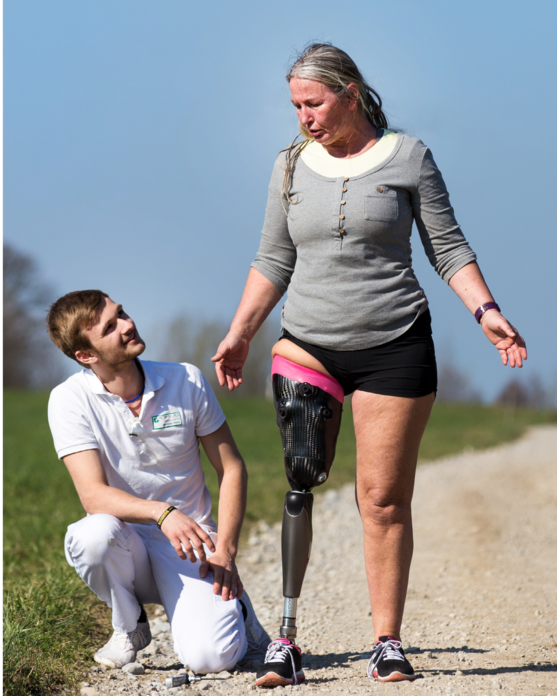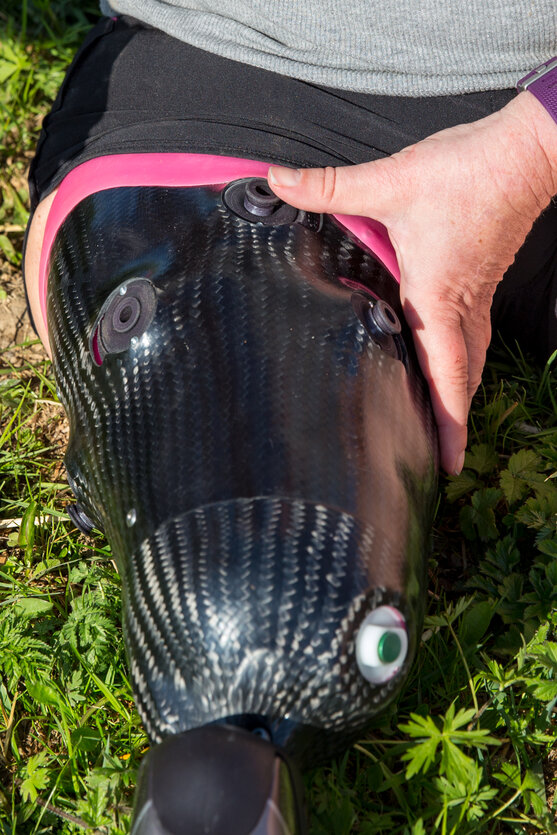
PBSS acupressure
Phantom pain treatment
Case description of a prosthetic treatment with a PBSS femur shaft with integrated acupressors for phantom pain treatment (N. Kommer, H. Engber, K. Pohlig, M. Schäfer)
A 51-year-old female patient with a femur amputation on the left also suffered after a two-year later post-amputation due to exostoses and a neuroma of such severe phantom pain that her quality of life was significantly impaired. This type of pain treatment was used because of an integrative addition to the Pohlig Bionic Socket System concept which is based on traditional Chinese medicine and allows the integration of “acupressors” into the prosthetic socket.
Introduction
Over two thirds of amputees suffer from phantom pain
A nationwide survey conducted by the Wiesbaden Pain and Palliative Center in 2006 revealed that 74.1% of all men and 76.8% of all women with amputations suffer from phantom pain. Phantom pain is usually described as burning, knife-like, electrifying or tingling pain. In 50% of patients, phantom pain can be caused or amplified by emotional stress. Other triggers may include infections of the upper airways, weather changes, cold stimuli, or trigger point contact. Pain usually increases during resting hours in the evening or at night. Early prosthesis placement may reduce the incidence of discomfort.
A complication-related course of revision surgery is likely to be a prejudicial factor. Therapeutic treatment is usually analgesic. Only a few patients will achieve complete pain relief on their own. Therefore, alternative treatment options have been established, which are often only practical to a limited extent. The efficacy and positive effects of acupuncture or acupressure on phantom pain are described in specialist books and have been demonstrated in studies [1,2].


History
With PBSS acupressure for pain relief
A cortisone injection administered in April 2002 resulted in a right knee infection in the patient. Despite immediate therapy, no improvement could be achieved. In addition to antibiotic treatment, several surgeries followed with rinsing and insertion of septopal chains. This treatment was also essentially unsuccessful, so the patient was eventually transferred to a specialist hospital. Although the infection could be remedied, the cartilage was already so damaged that a TEP had to be implanted in 2004. In 2006, the infection reappeared, which is why the TEP was removed and replaced with a spacer. Thigh amputation was chosen in May 2007.
The interim treatment was performed three weeks postoperatively. Prosthetic treatment was definitively provided at the end of 2007. However, in the summer of 2008, another revision was required to remove osteophytes. This was followed by the removal of a neuroma, with severe phantom pain occurring as early as one year after amputation.
The long history triggered long-term pain therapy with morphine extended-release tablets, which was initially increased to 100 mg/day due to the tenacity of the pain. The dose could be reduced to 32 mg/day during the further course of treatment.
In parallel to the drug pain therapy, a PBSS socket was supplied in August 2014 and equipped with PBSS acupressors [3]. At this time, the patient had two to four severe phantom pain seizures a month. The acupressure was applied every two hours during the day, for approx. 10–15 minutes. Prolonged use was not necessary after consulting with the TCM practitioner on a case-by-case basis.
During use, the patient was able to reduce the morphine dose to 24 mg/day. In September 2014, a final moderate pain attack took place. Then, with daily use, she was seizure-free until May 2015. Due to an increase in the volume of the stump, the prosthesis shaft had to be replaced. Delivery took place in July 2015 without acupressors.
After interruption of the acupressure treatment, phantom pain occurred again two to four times a month. Until the integration of the acupressors into the new prosthesis shaft, the patient will continue with the day-by-day use of the old shaft. Although it was significantly too tight, she reported that the acupressors were very effective and helped the pain to subside more quickly. The current morphine dose has stabilized permanently at 24 mg morphine/day (08/19/2015).
The new treatment with a PBSS shaft (four integrated acupressors) was completed on 04/11/2016. The patient reported that pain relief was restored after resuming use. In the following period, the acupressors were applied once a day for 20 min.


Critical assessment
Despite the limited value of case reports, this case tends to show that the temporal correlations are clear that alternative treatment options, such as acupressure, can certainly achieve treatment success.
The localization of the four acupressors was carried out together with an experienced physician and pain therapist, who also worked in China, in accordance with the guidelines of traditional Chinese medicine (TCM). Thanks to the easy handling of the acupressors, the treatment can be carried out by the user directly and without lead time. The daily duration of the acupressure and the intervals must be defined individually. The efficacy can be determined relatively quickly. In this case, a long-term effect is demonstrated by the permanent reduction of morphine.
This short case report illustrates that research must continue in the interest of those extremely plagued people in all directions, including the inclusion of alternative methods. A proof of effect can then be substantiated by a number of products, if necessary. Unfortunately, due to the low number and the great individuality, it will hardly be possible to conduct more extensive studies with great relevance. However, a start has been made. The patient, who was immensely plagued by phantom pain, was sustainably helped. [...].
Dr. Nikolaus Kommer
Surgeon
Klammstraße 15a
A-6330 Kufstein
Dr. med. Horst Engber
Specialist in Orthopedics
Crailsheimstraße 4
83278 Traunstein
Kurt Pohlig
Master orthopedic mechanic
c/o Pohlig GmbH
Grabenstätter Straße 1
83278 Traunstein
Michael Schäfer
Master orthopedic mechanic
Managing Director
c/o Pohlig GmbH
Grabenstätter Straße 1
83278 Traunstein
Sources:
[1] Wagner, F. (2012): Akupressur – Gräfe und Unzer-Verlag, p. 107
– Heilung auf den Punkt gebracht.
[2] Pouresmail, Z., Saberi, A. (2007): European Journal of Pain, The effect of acupressure on phantom pain in client with extremities amputation.
[3] Schäfer, M., Pohlig, K. (2014): Das Pohlig-Bionic-Socket-System (PBSS), Verlag Orthopädie-Technik, Dortmund 65(5):62–68.
